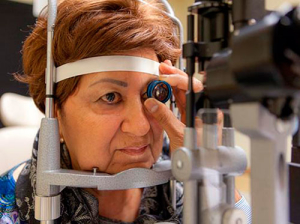 The University of Southern California (USC) Roski Eye Institute researchers and clinicians published results of the largest population-based study of adult Latinos and age-related macular degeneration (AMD) in the National Eye Institute-funded “Los Angeles Latino Eye Study (LALES).” The study, published in JAMA Ophthalmology, is the first to analyze the risk and prevalence of early and late stage AMD and its impact on quality of life for older Latinos.
The University of Southern California (USC) Roski Eye Institute researchers and clinicians published results of the largest population-based study of adult Latinos and age-related macular degeneration (AMD) in the National Eye Institute-funded “Los Angeles Latino Eye Study (LALES).” The study, published in JAMA Ophthalmology, is the first to analyze the risk and prevalence of early and late stage AMD and its impact on quality of life for older Latinos.
According to the National Eye Institute, AMD is a chronic, progressive disease affecting 2 million Americans and typically diagnosed in those age 50-60. The LALES study, conducted among 4,876 Latinos in Los Angeles with a mean age cohort of 54.8 years old, indicates that Latinos diagnosed with bilateral AMD with large drusen (the lipids or fatty proteins that are yellow deposits under the retina) and depigmentation as well as more severe AMD had a substantially lower health-related quality of life as compared to those with AMD lesions in only one eye.
In addition, the findings point to a more significant health-related quality of life decline beginning in early rather than later stages of the disease. For instance, the study shows 80 percent of early AMD participants reported difficulty driving as opposed to 43 percent who had late AMD. As well, 91.6 percent of early AMD participants reported vision-related social function impact and 74.4 percent had near vision problems as compared to 67.7 percent and 46.9 percent respectively of late AMD participants who reported the same. The researchers also found that while participants may not have a measurable decrease in their visual acuity, their reported reduced visual function may possibly be the result of contrast sensitivity associated with early-stage AMD.
“The study results are a wake-up call for both ophthalmologists and those in the Latino community to avoid a quality of life decline due to ocular conditions, especially in earlier stages of eye diseases such as AMD,” said Rohit Varma, MD, MPH, interim dean of the Keck School of Medicine of USC and director of the USC Roski Eye Institute. “What was significant but not intuitively obvious was that Latinos diagnosed with AMD in both eyes or more severe AMD had a markedly diminished vision-specific quality of life requiring us to shift our clinical focus from treating advanced stages of AMD to finding earlier stage interventions and treatment options.”
Dr. Varma, the study’s principal investigator and one of the world’s leading experts in population based eye disease, shared that objective measurements like vision loss may not adequately characterize the total impact of the ocular condition of a patient. The research points to the increasing need to assess a patient’s health-related quality of life and a patient’s overall perception of relative well-being as a valuable tool to evaluate treatment efficacies.
The Latino population is the largest minority segment of the U.S. population and is the largest ethnic population in Los Angeles county surpassing the Caucasian population in 2014. According to the U.S. Census 2015 report, Latinos are 17 percent of the U.S. population (55 million) and by 2060 they will be 29 percent (119 million). At the same time, American society has a growing aging population with 10,000 baby boomers turning 65 every day and AMD, an ocular disease that typically affects those age 50 and older, is the leading cause of irreversible blindness.
“Previous studies on Latinos have found this population to have a different pattern of AMD prevalence, incidence, progression and risk factors,” added Dr. Varma. “More importantly, the lower level of health care access and utilization among this group is likely to impact follow-up care of these patients and may make them more susceptible to diminished quality of life.”
“The LALES findings unexpectedly demonstrate that even the earliest stages of AMD may impair eyesight enough to interfere with daily activities. They also point to the need for additional research on the earliest stages of AMD,” said Maryann Redford, D.D.S., M.P.H., a program director for Collaborative Clinical Research at NIH’s National Eye Institute. “People with early AMD affecting both eyes appear to be especially vulnerable to declines in their vision-related quality of life, and might benefit from any early referral to a low vision specialist.”
The LALES study was conducted among 4,876 participants in six U.S. Census tracks in La Puente, Calif. More than half of the participants were female (59 percent) and 41 percent were male with a median cohort age of 54.8 years. The participants underwent comprehensive eye exams and interviews to assess risk factors for health-related quality of life impact related to either an early or late AMD diagnosis. Photographs of the inside of the eyes were taken to also detect signs of AMD. Typical AMD symptoms are straight lines or faces appear wavy, objects appear smaller or further away and there is blurriness or blind spots in central vision.
Dr. Varma is the principal investigator of many major National Institutes of Health (NIH)-funded studies, including the Multi-Ethnic Pediatric Eye Diseases Study (MEPEDS), African-American Eye Disease Study (AFEDS) and the Chinese-American Eye Study (CHES). The USC Roski Eye Institute is ranked in the Top 2 of the nation’s top grant recipients from the NEI and has achieved more than $32 million in annual grant funding.
This research was supported by NEI-funded grants EY-11753 and EY-03040.
By Sherri Snelling